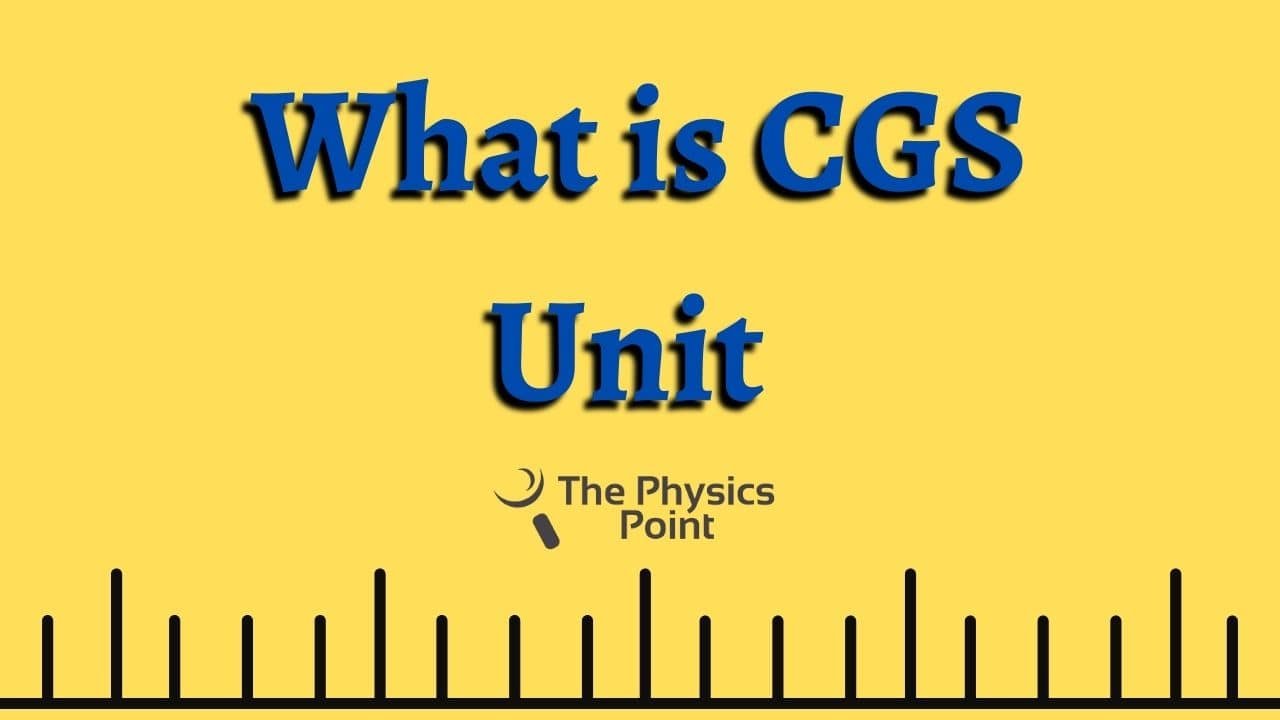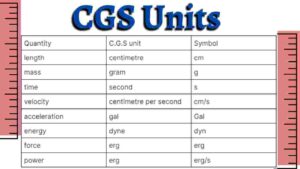What is CGS System in Physics? Definition and Meaning

Hello, friends welcome to this blog of Physics – The Physics Point. You are a very warm welcome to our website. Today we are presenting a new topic of physics, What is CGS? The previous article described the SI unit of measurement. That article told you many things about the SI System. Different types of unit systems for the measurement of physical quantities. The CGS system is one of them. There are three types of systems involved in the unit measurements that is the CGS system, the MKS System, and the FPS system. The length, Mass, and time are the primitive fundamental units of Physics and these quantities make other physical quantities by mixing themselves.
In today’s article, we will tell you some most useful topics and questions, like What, is CGS, What is CGS system, What is CGS system in physics, What are cgs units and cgs meaning, what cgs mean, what does cgs stand for, etc. These are very important questions from the exam point of view. We will also discuss in brief, the FPS system as well as the description of the fundamental unit. So without wasting much time, let’s move on to our main paragraph which is given below.
What is CGS (Definition)?
The C.G.S. system is a classical system of measurement. This CGS system was Proposed in 1832 by the great German mathematician Carl Friedrich Gauss. The full form of C.G.S. is known to be centimeter-gram-second, and it’s most used in the study of physics as well as chemistry also, especially in the fields of electrical and mechanical specialties. This CGS (centimeter-gram-second) system of similarly named units. We measured length here in centimeters and for the measurement of mass, we use the gram as a unit. Last but not least the time which we measure in seconds is very similar to the MKS system.
In physics or any subject, if we know the systems of units, we can easily convert one system of units to another system of units. This system of units has very flexibility to interconvert the units because it can divide and multiply with the powers of 10.

Lets us understand this with the help of an example, for example, the unit of force in the S.I. (International System of Units) system is Newton, and the unit of force in the C.G.S. (centimeter-gram-second system) is dyne. As we all know and we all studied that 1meter = 100cm and 1kg = 1000g. By putting these values in the unit of force, Newton which is expressed in this manner: 1 kg⋅m/s2, we get the unit of force now into the CGS system which is known as dynes ( expressed like 1g⋅cm/s2 ). Thus 1 newton comes out equal to 100000 dynes.
Similarly, we can convert many MKS units to CGS units by the process of upper unit conversion. In electromagnetism, electrostatic, etc some other systems of the unit are used. For example electrostatic units, electromagnetic units, Gaussian units, Lorentz-Heavisid units, etc. But the widely accepted Systems of units in Physics are Gaussian units.

Introduction to Fundamental Units
Fundamental units are the units in physics that cannot drive by other physical quantities. The most significant thing about these fundamentals they do not depend on other physical quantities. They are free from other units. We can easily say that these are basic units. Agar units such as dyne, Newton, erg, etc are the multiplication of beach fundamental physical quantities. You should know that there are three systems of units developed in Physics to measure physical quantities according to our needs.
There are in Physics, 7 fundamental quantities are developed that are given below-
- Length
- Mass
- Time
- Electric current
- Thermodynamics temperature
- Amount of substance
- Luminous intensity.
Brief info about the FPS system
This is another type of system of the unit in the Physics world. You know that the CGS system is also known as the Metric system whereas the FPS system is known as a non Metric system. Before the MKS system, the FPS system is globally accepted in the US and other European countries. The full form of this system is foot-pound-second. If you observe all systems of units, you will see that the unit of time is the same in all the systems of units that is second.
In the system, the unit of speed is foot per second and the unit of force is poundal. Here 1 poundal is equal to a 1-foot pound/second2.
Some Frequently Asked Questions (FAQs)
Ques. Who proposed the CGS system very first?
Ans. The CGS system was Proposed in 1832 by the great German mathematician Carl Friedrich Gauss.
Ques. What is the full form of the CGS system?
Ans. The full form of C.G.S. is known to be centimeter-gram-second, and it’s most used in the study of physics as well as chemistry also.
Ques. What is the full form of the MKS system?
Ans. The full form of the MKS system is the Meter, Kilogram, and Second system. In this widely accepted MKS system, fundamental units for length, mass, and time are meter, kilogram, and second respectively.
Ques. Dyne is the unit of which physical quantities?
Ans. Dyne is the unit of Force. This is a CGS unit. The MKS unit of Force is Newton. The 1 newton comes out equal to 100000 dynes.
The Conclusion
We hope you all read this article (What is CGS) very carefully. After reading this important article obviously, you have gained some knowledge about the CGS system as well as other important points such as what is cgs unit, the cgs system of units, cgs definition. If you guys really found this article What is CGS very very helpful to you then please share this with your friends also. We make every possible effort to make the article errorless. The next day, we will again meet with a fresh topic on Physics. Thanks to all!

Overflowing with gratitude!